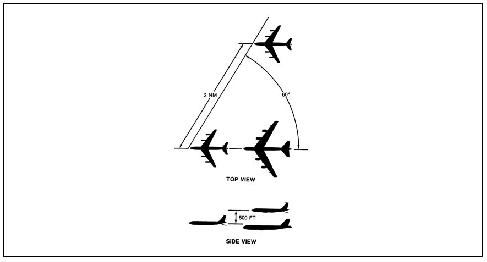Section 3. Military Formation Flight
This section prescribes policy, configurations, and separation standards for military formation flight.
The DoD has a continuing requirement, inherent through the nature of its mission, to operate aircraft in formation flight. In the interest of the public and the aviation community, it is imperative that controllers be knowledgeable of the various formation tactics employed by DoD aircraft.
A formation is defined as more than one aircraft that, by prior arrangement between the pilots, operates as a single aircraft with regard to navigation and position reporting. Separation between aircraft within the formation is the responsibility of the flight leader and the pilots of the other aircraft in the flight. This includes transition periods when aircraft within the formation are maneuvering to attain separation from each other to effect individual control and during join up or breakaway.
- Standard Formation. A formation in which a proximity of no more than 1 mile laterally or longitudinally and within 100 feet vertically from the flight leader is maintained by each wingman.
- Nonstandard Formation. A formation operating under any of the following conditions:
- When the flight leader has requested and air traffic control has approved other than standard formation dimensions.
- When operating within an authorized ALTRV or under the provisions of a letter of agreement.
- When the operations are conducted in airspace specifically designed for a special activity.
A formation departure consists of more than one aircraft at intervals of 1 minute or less which, by prior arrangement between the pilots, operate as a single aircraft with regard to navigation and position reporting. The departure portion of the flight may terminate at a preplanned breakup point which may be located up to, but not beyond, the planned initial level-off at cruise altitude. Formation flight requirements of paragraph 7-3-3 apply.
A cell formation flight is defined as two or more aircraft with the same intended route of flight maintaining station-keeping operations by either or both visual and electronic means. Formation flight requirements of paragraph 7-3-3 apply.
Some aircraft, due to their size and maneuverability, normally operate within a nonstandard cell formation. Bomber and tanker aircraft operating in a cell, operate with 1 nautical mile spacing (B-52 uses 2 nautical miles between cell members in trail and 500 feet vertical separation as illustrated in FIG 7-3-1 and FIG 7-3-2).
NOTE-
Controllers must not use the flight leader's Mode C readout for separation purposes. Asking the flight leader to “say altitude” only verifies the lead aircraft altitude.
- Formation Departure Procedures.
- B-52/KC-135/KC-10. Always operate in a nonstandard cell formation.
- Take-off interval: Normally, 1 minute between individual cell aircraft. KC-10 interval may be greater than 1 minute when individual aircraft gross weight will vary more than 100,000 pounds. The KC-10 flight leader will establish the interval and notify ATC what interval is being used.
- Intermediate level-off: Block altitude is required for any intermediate level-off altitude assigned by ATC. Wing aircraft “stack down” is with 500 feet vertical separation between each cell aircraft and close to en route longitudinal spacing. Vertical and longitudinal spacing may be greater than normal until level-off at cruise altitude is attained. Controllers must not use flight leader's Mode C readout for separation purposes until verification of formation configuration.
- En route formation: Non-standard with wing aircraft “stacked up” with 500 feet vertical separation and 1 nautical mile interval between aircraft as shown in FIG 7-3-1. The first aircraft maintains the base altitude assigned.
- B-1. Always operated in a nonstandard cell formation.
- Take-off interval: One minute between individual aircraft.
- Intermediate level-off: Block altitude is required for any intermediate level-off altitude assigned by ATC. Wing aircraft “stack down” with 500 feet vertical separation and close to 1 nautical mile longitudinal spacing. Separation and spacing may be greater until level-off cruise altitudes are attained. Controllers must not use flight leader's Mode C readout for separation purposes until verification of formation configuration.
- En route formation: Nonstandard with wing aircraft “stacked down” with 500 feet vertical separation and 1 nautical mile longitudinal spacing between aircraft as shown in FIG 7-3-2. The last aircraft maintains the base altitude assigned.
- En Route Cell Formation Procedures.
- En route cell formations operate in the non-standard formation configuration indicated in sub-paragraph a and shown in FIG 7-3-1 and FIG 7-3-2 except during aerial refueling. Aerial refueling formation configurations are shown in FIG 7-3-3, FIG 7-3-4, FIG 7-3-5, FIG 7-3-6, FIG 7-3-7, FIG 7-3-8, FIG 7-3-9, FIG 7-3-10, and FIG 7-3-11, Air Refueling Formation.
- Cell formation leaders are responsible for obtaining ATC approval to conduct formation flight operations in a nonstandard formation configuration.
- Unless otherwise directed by ATC, all aircraft within a cell formation will squawk the ATC assigned Mode 3A/C beacon code until established within the assigned altitude block and closed to the proper en route cell interval. When cell configuration requires an interval greater than 3 nautical miles between the formation leader and the last aircraft in the cell, both the formation leader and the last aircraft will squawk the assigned Mode 3A/C beacon code.
- After level-off at cruise altitude, should separation between the cell leader and any other aircraft exceed the ATC authorized dimensions for the nonstandard formation, the aircraft outside the formation limits will no longer be considered a part of the cell. The pilot of such aircraft must immediately notify the formation leader of the aircraft's position and request individual control from ATC until the aircraft is reestablished within the formation.
Separation standards applied to a nonstandard cell formation must be as indicated in the following:
- A single altitude/flight level must not be assigned to a nonstandard cell formation without concurrence of the formation leader.
- Air traffic control must meter other air traffic so as to permit assignment of sufficient altitudes to a nonstandard formation flight to allow intra-cell vertical spacing of 500 feet between each aircraft in the formation.
- En route longitudinal intra-cell spacing for a nonstandard formation is 1 nautical mile (B-52, 2 nautical miles) between individual cell aircraft. Air traffic control must apply approved separation criteria between the nonstandard formation envelope and other non-formation air traffic.
When military requirements dictate that large aircraft will conduct nonstandard formation flight, notification and approval must be accomplished by the following methods:
- The formation leader must indicate the number and type aircraft in the appropriate item of the military flight plan. In addition, “nonstandard cell formation” will be listed as the first entry in flight plan remarks.
- The formation leader must notify ATC upon initial contact that cell operations are being conducted in a nonstandard formation, and if required, advise ATC of the intra-cell separation and spacing being employed.
- During the departure phase of flight, the formation leader must not report level at an ATC assigned altitude or within an altitude block until all formation aircraft have attained the assigned altitude block.
Aerial refueling formations are always nonstandard and require additional airspace over a nonstandard cell formation as shown in FIG 7-3-3, FIG 7-3-4, FIG 7-3-5, FIG 7-3-6, FIG 7-3-7, FIG 7-3-8, FIG 7-3-9, FIG 7-3-10, and FIG 7-3-11.
- As shown by the illustrations in these figures, aerial refueling cells normally have a frontal width equal in nautical miles to the number of tanker aircraft contained within the cell. However, when the total number of receiver aircraft exceeds the number of tankers, the frontal width is correspondingly increased by 1 nautical mile for each additional receiver aircraft, but will not exceed 5 nautical miles.
- Controllers should exercise caution during en route, on course, or buddy refueling operations to ensure nonparticipating air traffic is provided sufficient lateral, longitudinal, or vertical separation from the refueling formation envelope to meet approved separation criteria.
FIG 7-3-1
En Route Cell (Stacked Up)
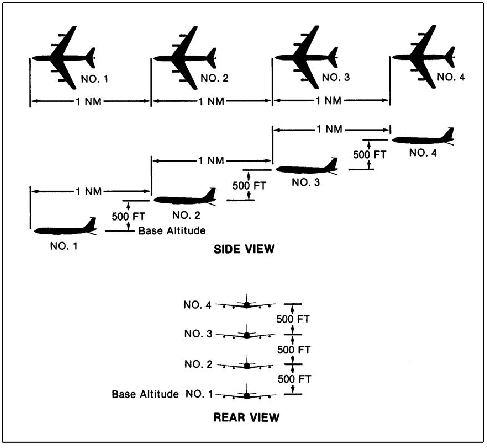
FIG 7-3-2
En Route Cell (Stacked Down)
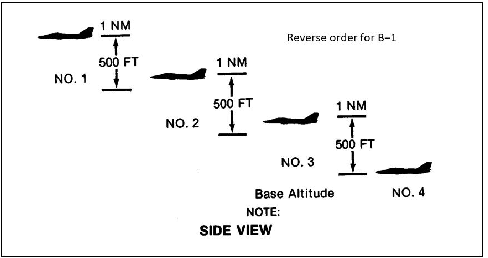
FIG 7-3-3
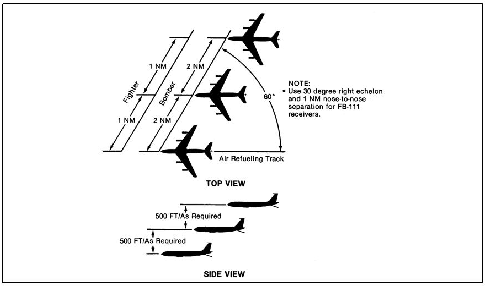
FIG 7-3-4
One Tanker/Three Receivers Air Refueling Visual Formation
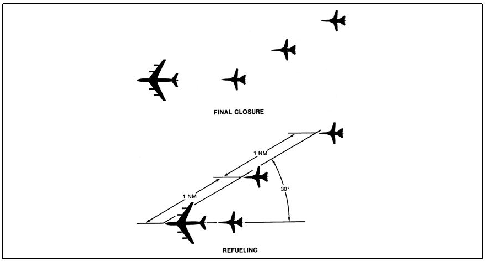
FIG 7-3-5
Tanker/Receiver Formation during Final Closure (One Tanker/One Receiver)
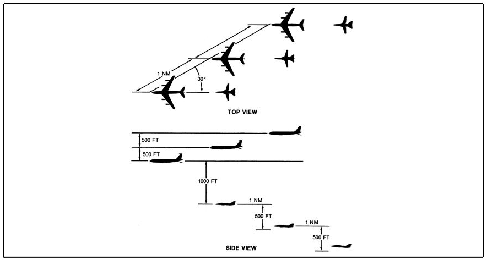
FIG 7-3-6
One Tanker/Three Receivers Air Refueling Cell Formation
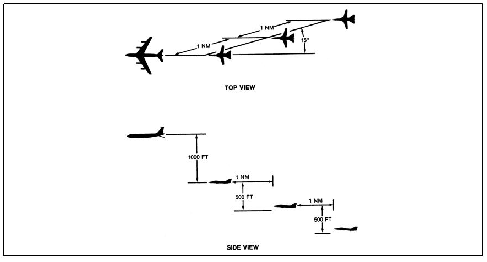
FIG 7-3-7
Receiver Formation (Six Receivers)
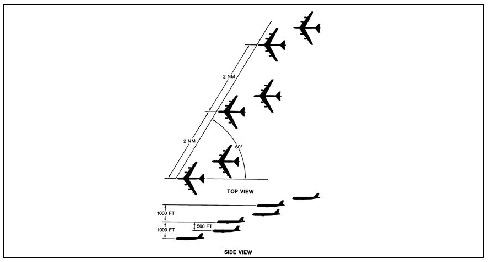
FIG 7-3-8
Receiver Formation (Three Receivers) and Formation Procedures (One Tanker/Three or More Receivers)
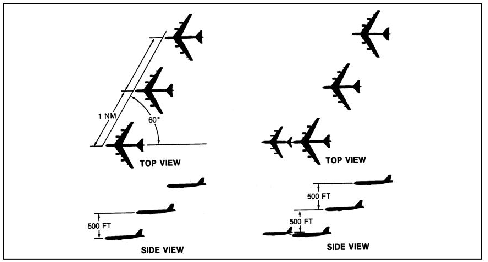
FIG 7-3-9
Formation Procedures (Three Tankers/Three Receivers)
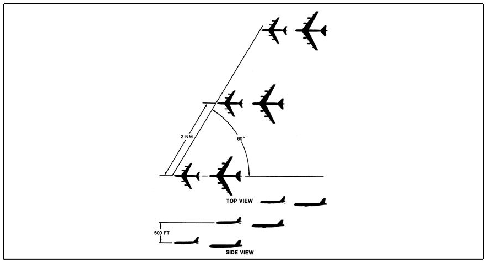
FIG 7-3-10
Formation Procedures (Three Tankers/Six Receivers)
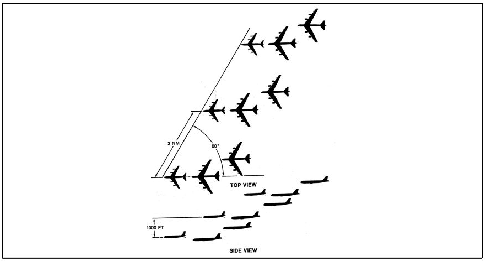
FIG 7-3-11
Formation Procedures (Two Tankers/One Receiver)
